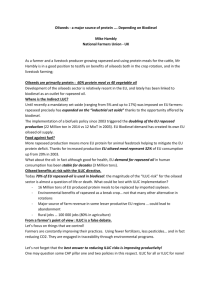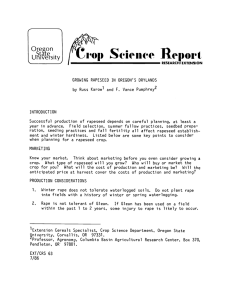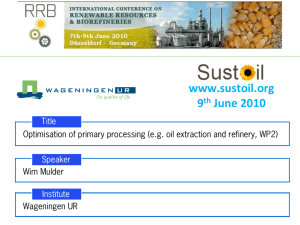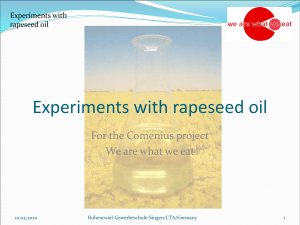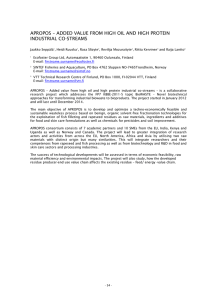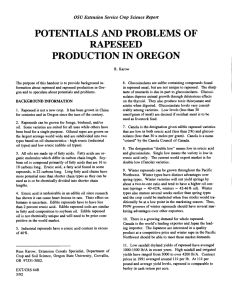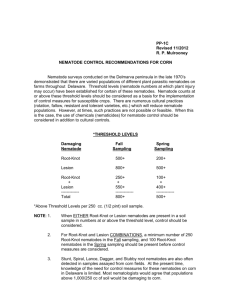E -A P R
advertisement
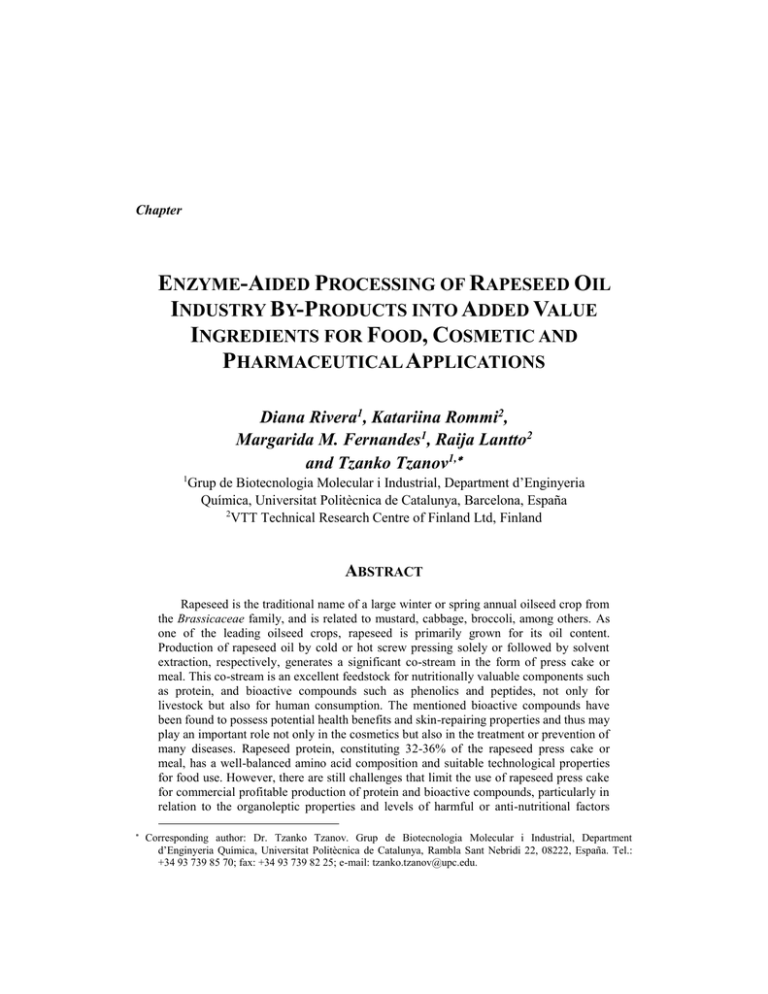
Chapter ENZYME-AIDED PROCESSING OF RAPESEED OIL INDUSTRY BY-PRODUCTS INTO ADDED VALUE INGREDIENTS FOR FOOD, COSMETIC AND PHARMACEUTICAL APPLICATIONS Diana Rivera1, Katariina Rommi2, Margarida M. Fernandes1, Raija Lantto2 and Tzanko Tzanov1, Grup de Biotecnologia Molecular i Industrial, Department d’Enginyeria Química, Universitat Politècnica de Catalunya, Barcelona, España 2 VTT Technical Research Centre of Finland Ltd, Finland 1 ABSTRACT Rapeseed is the traditional name of a large winter or spring annual oilseed crop from the Brassicaceae family, and is related to mustard, cabbage, broccoli, among others. As one of the leading oilseed crops, rapeseed is primarily grown for its oil content. Production of rapeseed oil by cold or hot screw pressing solely or followed by solvent extraction, respectively, generates a significant co-stream in the form of press cake or meal. This co-stream is an excellent feedstock for nutritionally valuable components such as protein, and bioactive compounds such as phenolics and peptides, not only for livestock but also for human consumption. The mentioned bioactive compounds have been found to possess potential health benefits and skin-repairing properties and thus may play an important role not only in the cosmetics but also in the treatment or prevention of many diseases. Rapeseed protein, constituting 32-36% of the rapeseed press cake or meal, has a well-balanced amino acid composition and suitable technological properties for food use. However, there are still challenges that limit the use of rapeseed press cake for commercial profitable production of protein and bioactive compounds, particularly in relation to the organoleptic properties and levels of harmful or anti-nutritional factors Corresponding author: Dr. Tzanko Tzanov. Grup de Biotecnologia Molecular i Industrial, Department d’Enginyeria Química, Universitat Politècnica de Catalunya, Rambla Sant Nebridi 22, 08222, España. Tel.: +34 93 739 85 70; fax: +34 93 739 82 25; e-mail: tzanko.tzanov@upc.edu. 2 Diana Rivera, Katariina Rommi, Margarida M. Fernandes et al. such as glucosinolates and phytates. The present chapter summarizes recent advances on the extraction processes of rapeseed-derived protein and bioactive compounds and reviews the possibilities as well as the challenges that these ingredients face regarding skin care, food and nutraceutical applications. INTRODUCTION Rapeseed, which comprises the species Brassica napus and Brassica rapa, is among the most important oilseed crops which are grown annually in temperate climates such as Europe, Canada, China, India and Australia [1, 2]. The seeds (containing 40-48% oil on dry matter basis) are currently processed to produce oil that is sold mainly to the food and biodiesel market, but it is also suitable as a raw material for lubricants, plastics, soaps, etc. Depending on the method of oil extraction, the residual seed mass can be designated as: i) the press cake, which is produced when only physical oil pressing is used, or ii) the meal, which is obtained when the pressing is followed by solvent extraction of residual oil from the press cake [3]. The continuous growth of rapeseed oil production for food and other uses coincides with proportional production of co-streams. Global rapeseed press cake/meal production increased by 80% between 2002 and 2012 [4]. Similarly, in the EU-27, rapeseed press cake/meal production doubled from 6,5 million tons in 2004 to 13,5 million tons in 2014 [5]. Large processing plants use hot pressing and solvent extraction to obtain rapeseed oil, while smaller producers of unrefined virgin oil mainly adopt the cold pressing process. There is a trend among consumers towards the use of unrefined virgin oil particularly in Europe and Northern America. This multiplies the small‐ and medium‐sized extraction plants producing virgin oil by cold pressing and consequently generating significant press cake co-stream. After processing rapeseed into oil, many valuable compounds such as proteins, carbohydrates, lipids and a range of other compounds such as polyphenols, phenolic acids and esters, glucosinolates, phytates, vitamins and minerals remain in the press cake/meal. The chemical composition and nutritional value of these co-streams are influenced by the processing technology and conditions used in the oil production such as type of the oil press, temperature, humidity during the extraction process, etc.) [6], but also by environmental factors like climate conditions, soil and fertilisation, not to mention genetic variation caused by breeding [7]. These conditions set the potential and limitations of the obtained co-streams for use in high-value applications [8]. In particular, the press cake from cold pressing of rapeseed is considered as a raw material for food protein production since protein quality is better retained in this feedstock than in the solvent-extracted meal. Current strategies for managing the co-streams include the use of press cake/meal as a protein source in feed formulations for animals, but also in lower value end-uses such as fertilizers or as a soil cover to prevent erosion. However, especially the press cake from cold pressing represents a rich source of native, high-quality protein and other bioactive compounds valuable as ingredients in foods, pharmaceuticals and cosmetics [9–14]. The press cake from cold pressing of whole rapeseeds contains 32-36% protein [15, 16], which is mainly comprised of the storage proteins cruciferin (12S globulin) and napin (2S albumin). The overall amino acid composition of these proteins is well-balanced with sufficient amounts of lysine and sulfur amino acids to meet the FAO requirements for daily intake [17, 18]. On the other hand, whole rapeseed protein seems to have limited digestibility in humans Enzyme-Aided Processing of Rapeseed Oil Industry By-Products … 3 similarly to many other plant proteins [18, 19]. The functional properties (solubility, thermal, emulsification, foaming and gelation properties) of rapeseed proteins have been well characterized with clear indications of their potential as performance ingredients in e.g., food and cosmetic products [20]. Additionally, several bioactivities including antioxidative, antihypertensive, antidiabetic, anorexigenic, hypocholesterolemic, anticancer and antiviral properties, have been identified in rapeseed proteins and peptides [21]. Despite the larger potential of rapeseed press cake, there are still technological barriers to its full profitable use. The presence of phytates, which are efficient chelators of minerals and proteins [22], phenolic compounds generating undesirable colours and flavours, traces of glucosinolates which are considered antinutritional for animals, but have a controversial role in human health [23], and the high carbohydrate content (36% on dry matter basis) which influences the digestibility and technological properties of the press cake [16]. Therefore, feasible technologies are needed in order to enhance the functionality, bioavailability, and sensory properties of rapeseed-derived ingredients both in food and skin care applications. Aqueous extraction of proteins in alkaline or saline conditions has been actively studied since the 1970’s with the aim to produce high-protein fractions for food use [24–26]. In addition, enzyme-aided processing using proteases and/or cell wall degrading enzymes has proven to be successful for the extraction of whole protein and protein hydrolysates from press cake and meal [16, 27–29]. The present chapter summarizes recent advances on the enzyme-assisted extraction processes of protein and other bioactive compounds from rapeseed press cake. It also reviews the potential use of these compounds in high value applications such as skin care, food and nutraceutical industries. SUSTAINABLE PROCESSING OF RAPESEED CO-STREAMS Oilseed proteins are most commonly enriched by alkaline extraction of defatted seed mass, followed by acidic precipitation and washing to yield a protein concentrate (>65% protein) or isolate (>90% protein). Although nearly pure protein can be obtained at a high yield, these technologies suffer from intensive water and energy consumption, use of chemicals, and requirement for multiple processing steps. High pH has been reported to expose proteins to denaturation, which reduces their solubility and related functional properties [30], and to increase the co-extraction of phenolic compounds with the protein [31]. To improve the feasibility, sustainability and economics of rapeseed protein production, alternative technologies such as dry fractionation and enzyme-assisted wet fractionation at reduced water content, have been the focus of several recent studies [16, 27–29, 32–36]. Dry fractionation is based on mechanical grinding and separation techniques and offers a sustainable approach for production of plant protein concentrates [33]. Dry fractionation is generally more energy-efficient than wet processing as there is no need for drying steps after the fractionation. Dry fractionation can also be regarded as a relatively mild way of processing since, although compromising the protein purity, it retains the natural functionality of the protein better than wet processing which is often carried out in severe pH and temperature conditions. Dry fractionation has been successfully used to enrich protein from pulses and cereals [33]. 4 Diana Rivera, Katariina Rommi, Margarida M. Fernandes et al. In rapeseed, protein and oil are mainly stored in the kernel of the seed which is surrounded by a hull rich in fibres and polyphenolics [37]. These components can have unfavourable effects on the sensory properties and digestibility of rapeseed protein products, and hence, removal of the hulls is recommended when targeting colour and flavour-neutral protein for food applications [38]. In our recent study, defatting of rapeseed cold-press cake by supercritical CO2 extraction and subsequent removal of the hull particles by milling and air classification produced a fine, light-coloured material with concomitant increase of protein content from 36 to 46% [32]. Removal of oil from the cold-press-cake is a required pretreatment and at the same time the major drawback of dry fractionation, since oil hinders the dispersion of milled particles during air classification [33]. Carbohydrate-hydrolysing enzymes, especially pectinase, cellulases, β-glucanase and xylanase, have proven useful for enrichment of rapeseed proteins. Carbohydrates constitute around 35% of rapeseed press cake [16], with pectin, cellulose, xyloglucan, arabinan and arabinogalactan being the main cell wall polysaccharides [39]. In the study by Niu et al. 2012, combined use of hemicellulase, pectinase, cellulase and protease enzymes enabled aqueous extraction of 82% of the total protein from rapeseed cold-press cake [28]. Such yield compares well with reported protein extraction yields from alkaline procedures, ranging from 56 [40] to 94% [41]. A patent by DeCastro et al. 2005 similarly describes a procedure where intermittent wet milling and enzymatic carbohydrate hydrolysis are used to recover a protein extract and oil-protein emulsion from thick slurry (19% solid content) of rapeseed cake and water [29]. Cell walls have been identified as one of the main physical barriers for protein release from various biomasses [42]. Pressing oil from rapeseeds partially disrupts seed cell walls and releases some protein from the kernel cells [16]. Cell wall degrading enzymes are expected to facilitate protein extraction from the press cake partly by disintegration of the remaining tissue [16]. Recently, we have revealed more mechanisms by which these enzymes influence rapeseed protein recovery, including the reduction of water-holding capacity of the press cake through pectin hydrolysis, and release of anionic compounds which improve protein solubility by electrostatic stabilization [34]. Enzyme treatment seems particularly beneficial when protein extraction is performed at increased solid content [34]. In these conditions, efficiency of solid-liquid separation by e.g., centrifugation is hindered by the high water holding capacity of rapeseed press cake, and carbohydrate-hydrolysing enzymes offer an effective tool to facilitate the processability of this material. In addition to facilitating protein extraction from the press cake without alkali or other chemicals, carbohydrate-hydrolysing enzyme treatment has also shown to improve functional properties of the resulting protein extracts [35]. Generally, use of these enzymes results in increased co-extraction of sugars and galacturonic acid [16]. Anionic carbohydrates are known to stabilize rapeseed protein dispersions by formation of electrostatic complexes [43, 44], and in a similar manner, uronic acids released during pectin hydrolysis have been suggested to increase the dispersion stability of enzymatically produced crude protein extracts [35]. Protein-hydrolysing enzymes i.e., proteases have been increasingly studied in the past decade as a gentle method for production of rapeseed protein hydrolysates with new functional properties. Hydrolysis of rapeseed proteins into soluble peptides can substantially facilitate their recovery from the press cake and solvent-extracted meal [27, 28]. The degree of hydrolysis influences not only the yield but also the functional and sensory properties of Enzyme-Aided Processing of Rapeseed Oil Industry By-Products … 5 the resulting peptides. Limited hydrolysis can improve the emulsifying and foaming activities and water and oil absorption capacities of rapeseed protein hydrolysates [12], while extensive hydrolysis may result in weakened functional properties [45] and formation of peptides with bitter taste [46]. On the other hand, small peptide size has been connected with certain bioactivities such as the inhibition of the angiotensin converting enzyme (ACE) involved in blood pressure regulation [47]. Various commercial protease preparations have proven effective for production of mixtures of bioactive rapeseed peptides. To maximize the yield of peptides, endopeptidases which cleave the peptide chains in the middle have been favoured over exopeptidases which release amino acids from peptide chain ends. The most studied preparations include B. lichenformis serine endopeptidases and mammalian gastrointestinal proteases [48]. VALORISATION OF RAPESEED CO-STREAMS INTO ADDED-VALUE APPLICATIONS Increasing global demand of proteins for human consumption and animal feeding has prompted the exploration of rapeseed industry co-streams, among others, as a novel protein source. Traditionally, rapeseed press cake/meal is used as animal feed, but its protein- and phenolic-rich nature, and the already proven bioactive properties of these compounds have found applications in other markets. Apart from food applications, their use as a resource for nutraceuticals and cosmeceuticals has been considered like various non-food applications such as films and paper additives [49]. Furthermore, it has been considered for its potential use in fermentative processes, including saccharification and production of enzymes, antibiotics, antioxidants and other by-products [50]. Annually, nearly 15 million tonnes of rapeseed co-streams are produced in Europe. The market price of press cake and meal used for animal feed is EUR 150-300/ton and the price of rapeseed oil varies between EUR 300 and 1400/ton [4]. in comparison, the price of plant protein ingredients such as soy protein isolates and hydrolysates ranges from 6000 to 7000 USD/ton [51], and the commercial value of food-quality rapeseed protein products made of press cakes could reach a similar level. So far, commercial value has not been estimated for the use of rapeseed press cake in cosmetics but an even higher value would be foreseen. Despite of these attractive price estimations, a small number of applications of the rapeseed co-streams are found in literature. Nevertheless, their potential use in added-value applications in food and cosmetic industry is a growing research interest. New and valuable compounds can be extracted and purified from rapeseed co-streams using technologies of varying complexity. One of the early rapeseed protein concentrates, generated after a dehulling process followed by a myrosinase inactivation, was reported to possess an acceptable light colour, neutral and bland flavour, and high nutritional value [52]. According to later studies, rapeseed protein isolates have shown favourable functional properties such as high emulsifying capacity [14] or gelation efficiency [53] depending on the production method and composition. It is important to consider that although certain nonprotein compounds such as phenolics can impair protein performance [54], high purity is not a prerequisite for suitable functional properties. In a recent study, a protein-rich fraction (46% protein) obtained by dry fractionation of defatted rapeseed press cake possessed lighter colour 6 Diana Rivera, Katariina Rommi, Margarida M. Fernandes et al. and higher dispersion stability than a rapeseed protein isolate (>90% protein) from wet fractionation [55]. The potential of rapeseed proteins in several food applications has been studied, though the brown colour of protein fractions, resulting from oxidation of phenolic compounds, is considered as a major limitation for their incorporation in food and other products [36, 48]. For example, rapeseed protein concentrates have been successfully applied as alternative for soy or lupine protein concentrates in sausage formulations to prevent water and oil separation [36, 48], and in bakery products and mayonnaise for complete substitution of egg protein. Yoshie-Stark et al. 2006 used a steaming process to obtain rapeseed protein concentrates for food applications [48]. When this protein concentrate was added to sausage preparations to replace casein, sensory analysis showed that the rapeseed protein sausage had improved taste, good texture and a characteristic aroma. Moreover, after hydrolysis with gastrointestinal enzymes, an improved angiotensin converting enzyme (ACE) inhibition and DPPH radical scavenging activity was observed [56]. Apart from the protein, rapeseed press cake has also attracted much attention as a source of antioxidative phenolic compounds such as sinapine and sinapic acid which are enriched in the kernel of the seeds [57]. Rapeseed phenolic extracts have proved effective in preventing unwanted oxidation of emulsions and oils [58, 59], therefore they can serve as natural preservatives in various food and cosmetic products. More recently, a rapeseed press cake valorisation approach performed in our group has revealed that the endopeptidases hydrolysis of press cake generated peptide-phenol fractions with improved antioxidant, antiinflammatory and anti-wrinkle activities important for anti-ageing properties, thereby setting these hydrolysates as potential ingredients for skin care applications [32]. LIMITATIONS AND POTENTIAL CHALLENGES While the potential use of rapeseed co-streams into added-value applications in food, cosmetics and biomedical industry is an exciting and growing area of research, there are a few risks and limitations that should be tackled before the widespread use of rapeseed press cake/meal-derived protein products in human consumption. Hence, it will take time to realise their potential as edible and safe raw materials for cosmetics or nutraceutical industries. Being novel food ingredients, rapeseed protein products will require special regulatory approval for marketing. To achieve this, trials are required that demonstrate the safety (animal/human testing data) of these compounds. Scientific data were presented to a regulatory agency, such as the US Food and Drug Administration (FDA) in order to confer a ‘Generally Regarded As Safe’ or ‘GRAS’ status for new food ingredients or processing aids. In the European Union and Canada, foods from non-traditional sources require approval under the Novel Food Legislation to ensure safety and clarity to the final consumer [60]. The first commercial rapeseed protein products by Burcon NutraScience Corporation received GRAS status in 2008, and in 2014 B. napus protein isolates were approved for marketing in Europe as novel food ingredients. Due to the absence of solid in vivo evidence and/or clinical data, frequency and administration of rapeseed bioactive compounds may be impossible to determine, leading to wide variability in intake and biological effects. Therefore, more investigation will be needed Enzyme-Aided Processing of Rapeseed Oil Industry By-Products … 7 before they could be released to the market for human care. [61]. Moreover, potential risk results from the presence of immunogenic proteins and peptides within the protein hydrolysates, which may induce and/or exacerbate allergic reactions in a minority of users [62, 63]. Another weak point is that due to the proteinaceous composition, rapeseed protein or peptide fractions may promote microbial contamination of skin care formulations. Therefore, the use of preservatives cannot be avoided. Further technological advancements are necessary to generate economically feasible and sustainable production processes for rapeseed protein and bioactives. Commercialization of rapeseed protein isolates is currently challenged by the high investment and operational costs of water and energy-intensive wet fractionation processes [33]. Therefore, future research should focus on reducing water and chemical consumption to obtain ingredients with sufficient quality at reasonable costs [36]. Feasible recovery of high-quality fractions is challenged by the complex composition of rapeseed press cake/meal. Distinct properties of the two major rapeseed proteins open up wide application potential, but at the same time complicate their efficient recovery without multiple processing steps. Secondly, phytates and phenolic compounds in rapeseed press cake have a strong tendency to interact with rapeseed proteins and peptides and, therefore, are difficult to separate from the final products [31, 64]. Intensive research has been carried out and is still needed to prevent the co-fractionation of these compounds with rapeseed proteins and peptides. CONCLUSION Given their large quantities, the management of rapeseed oil industry co-streams is a growing focus of interest. In fact, over the past few decades industrial actors from oilseed producers to rapeseed crushers, showed interest in diversifying the markets for oilseed cake/meal, and in particular, to obtain high added-value products such as nutraceuticals, cosmeceuticals, etc. While many researchers use different technologies to isolate proteins, phenolics and other interesting biocompounds mainly for food applications, others are more focused on the valorisation of these co-streams as a whole, avoiding expensive purification steps. The exploitation of these high protein industrial co-streams by using environmentally benign biomechanical and enzymatic processing technologies will surely bring new perspectives in food and skin care industries. In fact, the rapeseed industry, like many others that produce valuable waste and co-streams, offer plenty of potential and opportunities that may attract the attention of the stakeholders. Nevertheless, the adoption of ideas relevant to the biorefinery where rapeseed industry identifies these co-streams as potential sources of wealth aiming complete recycling and utilization are needed, rather than their rejection or application in low-profitable applications. Significant technological challenges need to be met before such changes are adopted by industry to satisfy current and future societal needs. REFERENCES [1] Fediol. Composition and Quality of Vegetable Oils and Fats. Rapeseed Oil; 2011. 8 [2] [3] [4] [5] [6] [7] [8] [9] [10] [11] [12] [13] [14] [15] [16] [17] [18] [19] Diana Rivera, Katariina Rommi, Margarida M. Fernandes et al. FAO. FAOSTAT Database http://faostat3.fao.org (accessed Jun. 26, 2015). Kolesárová, N., Hutan, M., Bodík, I., Špalková, V. Utilization of Biodiesel by-Products for Biogas Production. J. Biomed. Biotechnol. 2011, 2011. Carré, P., Pouzet, A. Rapeseed Market, Worldwide and in Europe. OCL 2014, 21 (1), D102. Fediol. Meals - EU Production, Imports, Exports and Consumption. Leming, R., Lember, A. Chemical Composition of Expeller-Extraced and Cold-Pressed Rapeseed Cake. Agraart. J. Agric. Sci. 2005, 16 (2), 103-109. Eriksson, I., Westerlund, E., Åman, P. Chemical Composition in Varieties of Rapeseed and Turnip Rapeseed, Including Several Samples of Hull and Dehulled Seed. J. Sci. Food Agric. 1994, 66, 233-240. Bellostas, N., Sørensen, H., Sørensen, S. Nutrition and Processing Workshop: Quality of Rapeseed Oil for Non-Food (bioenergy), and Human and Animal Nutrition. In: 12th International Rapeseed Congress; 2007; pp. 1-7. Ramachandran, S., Kumar, S., Larroche, C., Ricardo, C., Pandey, A. Oil Cakes and Their Biotechnological Applications – A Review. Bioresour. Technol. 2009, 98 (2007), 2000-2009. Kim, S. M., Na, M. S. A Study on Skin Care Effects of Rapeseed Meal Extract. Korean Soc. Biotechnol. Bioeng. 2013, 28 (3), 177-184. Pedroche, J., Yust, M. M., Megías, C., Lqari, H., Alaiz, M., Girón-calle, J., Millán, F., Vioque, J., Pedroche, P. J. Utilisation of Rapeseed Protein Isolates for Production of Peptides with Angiotensin I-Converting Enzyme (ACE) - Inhibitory Activity. Grasas y aceites 2004, 55, 354-358. Vioque, J., Sánchez-vioque, R., Clemente, A., Pedroche, J., Millán, F. Partially Hydrolyzed Rapeseed Protein Isolates with Improved Functional Properties. J. Am. Oil Chem. Soc. 2000, 77 (4), 447-450. McCarthy, A., O’Callaghan, Y., O’Brien, N. Protein Hydrolysates from Agricultural Crops-Bioactivity and Potential for Functional Food Development. Agriculture 2013, 3 (1), 112-130. Yoshie-Stark, Y., Wada, Y., Wäsche, A. Chemical Composition, Functional Properties, and Bioactivities of Rapeseed Protein Isolates. Food Chem. 2008, 107, 32-39. Schöne, F., Kirchheim, U., Schumann, W., Lüdke, H. Apparent Digestibility of HighFat Rapeseed Press Cake in Growing Pigs and Effects on Feed Intake, Growth and Weight of Thyroid and Liver. Anim. Feed Sci. Technol. 1996, 62 (2), 97-110. Rommi, K., Hakala, T. K., Holopainen, U., Nordlund, E.; Poutanen, K., Lantto, R. Effect of Enzyme-Aided Cell Wall Disintegration on Protein Extractability from Intact and Dehulled Rapeseed (Brassica Rapa L. and Brassica Napus L.) Press Cakes. J. Agric. Food Chem. 2014, 62 (32), 7989-7997. Tenore, G. C., Troisi, J., Di Fiore, R., Basile, A., Novellino, E. Chemical Composition, Antioxidant and Antimicrobial Properties of Rapa Catozza Napoletana (Brassica Rapa L. Var. Rapa DC.) Seed Meal, a Promising Protein Source of Campania Region (southern Italy) Horticultural Germplasm. J. Sci. Food Agric. 2012, 92 (8), 1716-1724. WHO. Protein and Amino Acid Requirements in Human Nutrition; Geneva, 2007. Bos, C., Airinei, G., Mariotti, F., Benamouzig, R., Bérot, S.,Evrard, J., Fénart, E., Tomé, D., Gaudichon, C. The Poor Digestibility of Rapeseed Protein Is Balanced by Its Very High Metabolic Utilization in Humans. J. Nutr. 2007, 137 (3), 594-600. Enzyme-Aided Processing of Rapeseed Oil Industry By-Products … 9 [20] Wanasundara, J. P. D. Proteins of Brassicaceae Oilseeds and Their Potential as a Plant Protein Source. Crit. Rev. Food Sci. Nutr. 2011, 51 (7), 635-677. [21] Aachary, A. A., Thiyam, U. A Pursuit of the Functional Nutritional and Bioactive Properties of Canola Proteins and Peptides. Crit. Rev. Food Sci. Nutr. 2012, 52 (11), 965-979. [22] Kumar, V., Sinha, A. K., Makkar, H. P. S., Becker, K. Dietary Roles of Phytate and Phytase in Human Nutrition: A Review. Food Chem. 2010, 120 (4), 945-959. [23] Cartea, M. E., Velasco, P. Glucosinolates in Brassica Foods: Bioavailability in Food and Significance for Human Health. Phytochem. Rev. 2008, 7 (2), 213-229. [24] Bérot, S., Compoint, J. P., Larré, C., Malabat, C., Guéguen, J. Large Scale Purification of Rapeseed Proteins (Brassica Napus L.). J. Chromatogr. B 2005, 818 (1), 35-42. [25] Ghodsvali, A., Khodaparast, M. H. H., Vosoughi, M., Diosady, L. L. Preparation of Canola Protein Materials Using Membrane Technology and Evaluation of Meals Functional Properties. Food Res. Int. 2005, 38 (2), 223-231. [26] Xu, L., Diosady, L. L. Processing of Canola Proteins. A Review. In: Canola and Rapeseed: Production, Processing, Food Quality, and Nutrition; Thiyam-Holländer, U., Eskin, M. N. A., Matthäus, B., Eds.; CRC Press: Boca Raton, 2012; pp. 59-78. [27] Sari, Y. W., Bruins, M. E., Sanders, J. P. M. Enzyme Assisted Protein Extraction from Rapeseed, Soybean, and Microalgae Meals. Ind. Crops Prod. 2013, 43 (1), 78-83. [28] Niu, Y. X., Li, W., Zhu, J., Huang, Q., Jiang, M., Huang, F. Aqueous Enzymatic Extraction of Rapeseed Oil and Protein from Dehulled Cold-Pressed Double-Low Rapeseed Cake. Int. J. Food Eng. 2012, 8 (3), 1-14. [29] DeCastro, F. B., Carlsson, T. I., Kvist, S. U., Lawther, J. M. Process for the Fractionation of Oilseed Press Cakes and Meals, 2005. [30] Ma, C.-Y., Harwalkar, V. R., Paquet, A. Physicochemical Properties of Alkali-Treated Oat Globulin. J. Agric. Food Chem. 1990, 38, 1707-1711. [31] Xu, L., Diosady, L. L. Interactions between Canola Proteins and Phenolic Compounds in Aqueous Media. Food Res. Int. 2000, 33 (9), 725-731. [32] Rivera, D., Rommi, K., Fernandes, M. M., Lantto, R., Tzanov, T. Biocompounds from Rapeseed Oil Industry Co-Stream as Active Ingredients for Skin Care Applications. Int. J. Cosmet. Sci. 2015, 37, 496-505. [33] Schutyser, M. A. I., van der Goot, A. J. The Potential of Dry Fractionation Processes for Sustainable Plant Protein Production. Trends Food Sci. Technol. 2011, 22 (4), 154164. [34] Rommi, K., Holopainen, U., Pohjola, S., Hakala, T. K., Lantto, R., Poutanen, K., Nordlund, E. Impact of Particle Size Reduction and Carbohydrate-Hydrolyzing Enzyme Treatment on Protein Recovery from Rapeseed (Brassica Rapa L.) Press Cake. Food Bioprocess Technol. 2015. [35] Rommi, K., Ercili-Cura, D., Hakala, T. K., Nordlund, E., Poutanen, K., Lantto, R. Impact of Total Solid Content and Extraction pH on Enzyme-Aided Recovery of Protein from Defatted Rapeseed (Brassica Rapa L.) Press Cake and Physicochemical Properties of the Protein Fractions. J. Agric. Food Chem. 2015, 63 (11), 2997-3003. [36] Von Der Haar, D., Müller, K., Bader-Mittermaier, S., Eisner, P. Rapeseed Proteins – Production Methods and Possible Application Ranges. Oilseeds fats Crop. Lipids 2014, 21 (1), 1-8. 10 Diana Rivera, Katariina Rommi, Margarida M. Fernandes et al. [37] Hu, Z.-Y., Hua, W., Zhang, L., Deng, L.-B., Wang, X.-F., Liu, G.-H., Hao, W.-J., Wang, H.-Z. Seed Structure Characteristics to Form Ultrahigh Oil Content in Rapeseed. PLoS One 2013, 8 (4), 1-10. [38] Naczk, M., Amarowicz, R., Shahidi, F. Role of Phenolics in Flavor of Rapeseed Protein Products. Dev. Food Sci. 1998, 40, 597-613. [39] Pustjens, A. M., Schols, H. A., Kabel, M. A., Gruppen, H. Characterisation of Cell Wall Polysaccharides from Rapeseed (Brassica Napus) Meal. Carbohydr. Polym. 2013, 98, 1650-1656. [40] Akbari, A., Wu, J. An Integrated Method of Isolating Napin and Cruciferin from Defatted Canola Meal. LWT - Food Sci. Technol. Sci. Technol. 2015, 64, 308-315. [41] Zhou, B., He, Z., Yu, H., Mukherjee, K. D. Proteins from Double-Zero Rapeseed. J. Agric. Food Chem. 1990, 38 (3), 690-694. [42] Sari, Y. W., Syafitri, U., Sanders, J. P. M., Bruins, M. E. How Biomass Composition Determines Protein Extractability. Ind. Crops Prod. 2015, 70, 125-133. [43] Klassen, D. R., Elmer, C. M., Nickerson, M. T. Associative Phase Separation Involving Canola Protein Isolate with Both Sulphated and Carboxylated Polysaccharides. Food Chem. 2011, 126 (3), 1094-1101. [44] Stone, A. K., Teymurova, A., Dang, Q., Abeysekara, S., Karalash, A., Nickerson, M. T. Formation and Functional Attributes of Electrostatic Complexes Involving Napin Protein Isolate and Anionic Polysaccharides. Eur. Food Res. Technol. 2014, 238 (5), 773-780. [45] Vioque, J., Sanchez-Vioque, R., Clemente, A., Pedroche, J., Bautista, J., Millan, F. Production and Characterization of an Extensive Rapeseed Protein Hydrolysate. J. Am. Oil Chem. Soc. 1999, 76 (7), 819-823. [46] Kim, H.-O., Li-Chan, E. C. Y. Quantitative Structure-Activity Relationship Study of Bitter Peptides. J. Agric. Food Chem. 2006, 54 (26), 10102-10111. [47] Wu, J., Aluko, R. E., Muir, A. D. Purification of Angiotensin I-Converting EnzymeInhibitory Peptides from the Enzymatic Hydrolysate of Defatted Canola Meal. Food Chem. 2008, 111 (4), 942-950. [48] Yoshie-Stark, Y., Wada, Y., Schott, M., Wäsche, A. Functional and Bioactive Properties of Rapeseed Protein Concentrates and Sensory Analysis of Food Application with Rapeseed Protein Concentrates. LWT - Food Sci. Technol. 2006, 39 (5), 503-512. [49] Pudel, F. Recent Results on Extraction and Application. In: Canola and Rapeseed Production, Processing, Food Quality, and Nutrition; Thiyam-Holländer, U., Michael Eskin, N. A., Matthäus, B., Eds.; CRC Press, Taylor and Francis Group, 2012; pp. 186202. [50] Lomascolo, A., Uzan-Boukhris, E., Sigoillot, J.-C., Fine, F. Rapeseed and Sunflower Meal: A Review on Biotechnology Status and Challenges. Appl. Microbiol. Biotechnol. 2012, 95 (5), 1105-1114. [51] Frost and Sullivan. Analysis of the Global Protein Ingredients Market; 2013. [52] Stensson Anjou, K. O., Jeny Fecske, A., Car, G. K., Ragnar Ohlson, J. S. Production of Rapeseed Protein Concentrate for Human Consumption, 1978. [53] Krause, J.-P., Schwenke, K. D. Behaviour of a Protein Isolate from Rapeseed (Brassica Napus) and Its Main Protein Components - Globulin and Albumin - at Air/solution and Solid Interfaces, and in Emulsions. Colloids Surf. B. Biointerfaces 2001, 21 (1-3), 2936. Enzyme-Aided Processing of Rapeseed Oil Industry By-Products … 11 [54] Rubino, M. I., Amfield, S. D., Nadon, C. A., Bernatsky, A. Phenolic Protein Interactions in Relation to the Gelation Properties of Canola Protein. Food Res. Int. 1996, 29 (7), 653-659. [55] Partanen, R., Sibakov, J., Rommi, K., Hakala, T., Holopainen-Mantila, U., Lahtinen, P., Ercili Cura, D., Lantto, R. Modifying the Colloidal State of Non-Refined Rapeseed (Brassica Rapa) Protein Concentrate by Microfluidization. [56] Yoshie-Stark, Y., Wada, Y., Schott, M., Wäsche, A. Functional and Bioactive Properties of Rapeseed Protein Concentrates and Sensory Analysis of Food Application with Rapeseed Protein Concentrates. LWT - Food Sci. Technol. 2006, 39 (5), 503-512. [57] Chen, Y., Thiyam-Hollander, U., Barthet, V. J., Aachary, A. A. Value-Added Potential of Expeller-Pressed Canola Oil Refining: Characterization of Sinapic Acid Derivatives and Tocopherols from Byproducts. J. Agric. Food Chem. 2014, 62 (40), 9800-9807. [58] Sørensen, A.-D. M. D. M., Friel, J., Winkler-Moser, J. K., Jacobsen, C., Huidrom, D., Reddy, N., Thiyam-Holländer, U. Impact of Endogenous Canola Phenolics on the Oxidative Stability of Oil-in-Water Emulsions. Eur. J. Lipid Sci. Technol. 2013, 115 (5), 501-512. [59] Thiyam, U., Stöckmann, H., Zum Felde, T., Schwarz, K. Antioxidative Effect of the Main Sinapic Acid Derivatives from Rapeseed and Mustard Oil by-Products. Eur. J. Lipid Sci. Technol. 2006, 108 (3), 239-248. [60] Arntfield, S. D. Canola and Other Oilseed Proteins. In: Handbook of food proteins; Woodhead Publishing Limited: Manitoba, 2011; pp. 289-315. [61] Chakrabarti, S., Forough, J., Wu, J., Jahandideh, F., Wu, J. Food-Derived Bioactive Peptides on Inflammation and Oxidative Stress. Biomed Res. Int. 2014, 2014, DOI: 10. 1155/2014/608979. [62] Akiyama, H., Sakata, K., Yoshioka, Y., Murata, Y., Ishihara, Y., Teshima, R., Sawada, J., Maitani, T. Profile Analysis and Immunoglobulin E Reactivity of Wheat Protein Hydrolysates. Int. Arch. Allergy Immunol. 2006, 140 (1), 36-42. [63] Puumalainen, T. J., Puustinen, A., Poikonen, S., Turjanmaa, K., Palosuo, T., Vaali, K. Proteomic Identification of Allergenic Seed Proteins, Napin and Cruciferin, from ColdPressed Rapeseed Oils. Food Chem. 2015, 175, 381-385. [64] Schwenke, K. D., Mothes, R., Marzilger, K., Borowska, J., Kozlowska, H. Rapeseed Protein Polyanion Interactions - Turbidimetric Studies in Systems with PhosphateContaining Polyanions: Phytic Acid and Octametaphosphate. Food/Nahrung 1987, 31 (10), 1001-1013. N.G.
